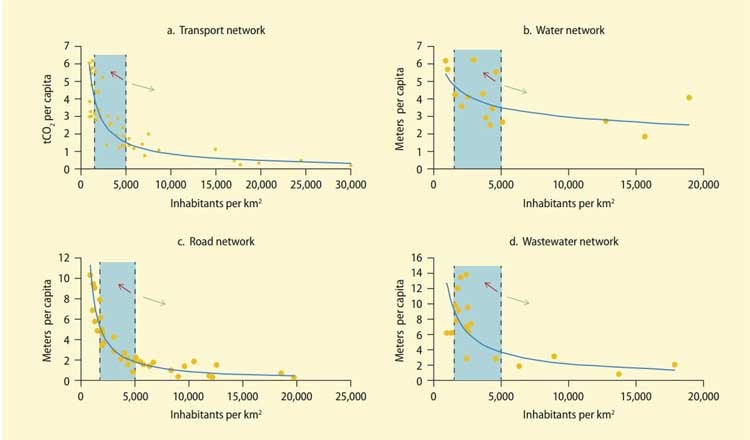
Ending Global Sprawl: Plan for Growth, Resilience and Preservation
This article was originally published in Ending Global Sprawl: Urban Standards for Sustainable and Resilient Development, written by Peter Calthorpe and published by the World Bank's Global Platform for Sustainable Cities. Ending Global Sprawl explores forward-thinking planning strategies for the urban form.
Principle 1: Plan for Growth, Resilience and Preservation
Plan for compact growth and resilience while preserving natural ecologies, agrarian landscapes, and cultural heritage sites.
Rationale and Challenges
The foundation of any regionwide plan must value and strategically preserve critical agrarian assets, ecological resources, and cultural heritage sites while providing designated sites for population and economic growth. Mapping and incorporating these areas into a growth strategy is critical. In addition, maintaining density in new growth areas while providing adequate land for new development is a critical balance in smart growth strategies. Identifying and targeting key infill and redevelopment areas can enhance overall regional density while reinforcing development in accessible areas.
The use of urban growth boundaries can help achieve compact development, preserve farmlands and environmental assets along with enabling conditions for shorter commutes while supporting greater use of transit, walking, and biking. UGBs can prevent sprawl in all of its forms and other worst outcomes by protecting agricultural land, reducing traffic problems, and decreasing air pollution. Compact mixed-use development increases the efficiency of public infrastructure and is best supported by growth boundaries. This compact growth strategy can increase the value of the built environment while reducing housing and transportation costs.
UGBs should become a required element of every city and regional plan. Without them, cities tend to sprawl outward, often with low-density development, consuming natural landscapes and precious farmlands and exacerbating infrastructure and transit challenges. Once established, the UGB can be modified only if, and when, the population targets are expanded and no additional capacity for infill and redevelopment is available within the boundary. Consequently, UGBs require a thorough evaluation of projected population growth as well as a clear and agreed upon vision for a city’s growth.
Goals and Actions
1A: Create a compact metropolitan form that facilitates preservation of ecologies, agrarian landscapes, and heritage sites and avoids climate hazard zones
- ACTION 1: Establish a rational growth target and economic development strategy
- ACTION 2: Establish an UGB enforcement mechanism and periodically update the UGB based on economic growth projections
1B: Prioritize redevelopment and infill development in areas safe from climate change impacts
- ACTION 3: Assess and designate redevelopment sites based on minimum density, decay, hazard designations, and economic development needs
- ACTION 4: Create incentives to prioritize infill and redevelopment in climate hazard-free zones
1C: Preserve ecological, agricultural, historical, and cultural resources
- ACTION 5: Map historic, cultural, and ecological resources
- ACTION 6: Map productive agricultural lands and assess rural villages
Metrics
1.1: Urban Growth Boundary
Establish a 20-year Urban Growth Boundary that maintains adequate developable land for the projected future population and economic growth based on environmental assessments
1.2: Redevelopment
Adopt a citywide redevelopment strategy for areas of blight, transit-oriented development sites, and economic redevelopment opportunity
1.3: Resource Preservation
Adopt a preservation strategy for historic, cultural, and ecological assets
1.4: Agriculture and Villages
Rank and designate productive agricultural lands and rural villages appropriate for preservation.

Benefits
Economic
- Avoids the hidden costs of sprawl: Low-density development patterns cost the U.S. economy $1 trillion annually due to lost productivity and worsened health, especially from increased rates of obesity.
- Reduces infrastructure costs: By concentrating development, governments can more efficiently provide public infrastructure. In contrast, sprawl means lower rates of utilization and higher per capita costs.
- Improves land-use efficiency: Compact growth increases property values. It also increases the productivity of urban land use as measured in economic output per square kilometer.
- Lowers transportation costs: While higher property values are good for developers and property owners, higher housing costs impose challenges for homeowners. With proper transportation policies, compact development can improve overall affordability as measured by housing plus transportation costs. In many developing countries, the working poor are penalized with long expensive commutes from remote areas and poor transit options.
Environmental
- Protects natural resources: Development in and adjacent to developed areas that already have the needed infrastructure can help prevent sprawl while protecting natural resources such as wetlands, streams, coastlines, and critical habitat.
- Reduces car dependence and transportation energy demand: By 2030, urban growth boundaries and other improved urban design features, such as those recommended in these guidelines, can reduce national demand for transportation fuel by 21% in China. For new towns, the potential is greater, with at least 50% savings possible.
- Promotes cleaner air: Reduced transportation demand in vehicle kilometers traveled (VKT) has a commensurate reduction in air pollution.
Social
- Creates community cohesion: Compact development helps bring people together while sprawl isolates individuals and households with single-use zoning.
- Improves access to services and jobs: Compactness not only reduces the distances that must be travelled, but the resulting density supports a great supply and diversity of local goods and services.
- Improves access to mobility: Lower transportation costs can ease the burden on lower income groups. More compact development can be more efficiently served by a range of transit and shared mobility technologies.
About the Author: Peter Calthorpe

Peter’s long and honored career in urban design, planning and architecture began in 1976, combining his experience in each discipline to develop new approaches to urban revitalization, suburban growth and regional planning. In 1983, Peter founded the award-winning firm of Calthorpe Associates devoted to sustainable urban design and planning globally. In May 2019, Calthorpe Associates joined HDR. Throughout his career in urban design, planning and architecture, he has been a pioneer of innovative approaches to urban revitalization, community planning, and regional design. For his contribution in redefining the models of urban and suburban growth, he was awarded Urban Land Institute's prestigious J.C. Nichols Prize for Visionaries in Urban Development in 2006. He is one of the founders and the first board president of Congress for the New Urbanism. Metropolis Magazine claims: "The titles of Peter Calthorpe’s books define the recent history of urban design in its most vital and prescient manifestations."

